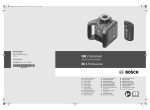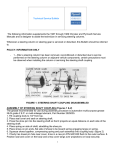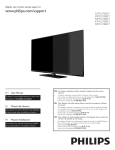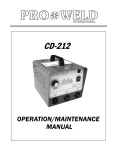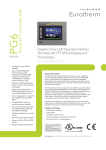Download EXHAUST SYSTEM
Transcript
'GROUP 11 EXHAUST SYSTEM CONTINTS DESCRIPTION . . . . . . . . . . . . . . . . . SERVICE DIAGNOSIS Page Page 1 1 SERVICE PROCEDURES . . . . . . . . 1 TIGHTENING REFERENCE . In Rear of the Manual .. Description Long life aluminized and stainless steel muffler components are used on all models. Mufflers on AC-1, AC-2 and AC-3 models are supported at the rear by double strap hangers. " L " type hangers are used to support the tail pipes on all models (Figs. 1, 2, 3 and 4). Ball joint connections which allow more accurate alignment of the exhaust system are located i n the exhaust pipes forward of the mufflers on all models. (Figs. 1, 2, 3 and 4). The exhaust manifolds on all engines incorporate a thermostatic heat control valve to direct the exhaust gases to a heat chamber beneath the carburetor mounting flange to help vaporize the fuel. The heat control valve is located i n the right hand manifold (Figs. 6 and 7). SERVIC1 D I A G N O S I S Condition Correction Possible C a u s e EXHAUST SYSTEM EXCESSIVE EXHAUST NOISE (a) Leaks a t the pipe joints. ( a ) Tighten the clamps a t the leaking joints. (b) Burned or blown out muffler. (b) Replace the muffler assembly. (c) Burned or rusted out exhaust pipe. (c) Replace the exhaust pipe. (d) Exhaust pipe leaking a t the manifold flange. (d) Install a new gasket a n d tighten the exhaust (e) Exhaust manifold c r a c k e d or broken. (e) Replace the manifold. (f) (f) Tighten the manifold to cylinder block nuts to pipe flange nuts to specifications. Leak between the manifold a n d cylinder block. specifications. LEAKING EXHAUST GASES (a) Leaks a t the pipe joints. ( a ) Tighten the clamps a t the leaking joints. (b) D a m a g e d or improperly installed gaskets. (b) Replace gaskets as necessary. (c) Restriction in muffler or tail pipe. (c) Remove the restriction, if possible or replace a s necessary. ENGINE HARD TO (a) Heat control valve frozen in the open position. (a) Free up the manifold heat control v a l v e solvent number, 1879318. W A R M UP O R WILL NOT RETURN TO NORMAL IDLE NOISE IN MANIFOLD MANIFOLD HEAT CONTROL VALVE RATTLE (a) Thermostat broken. ( a ) Replace the thermostat. (b) W e a k or broken anti-rattle spring. (b) Replace the spring. (a) Thermostat broken. ( a ) Replace the thermostat. (b) Broken, w e a k or missing anti-rattle spring. (b) Replace the spring. SERVICE PROCEDURES EXHAUST PIPES, MUFFLERS, TAIL PIPES Removal (1) Raise the vehicle on a hoist and lubricate the clamp nuts and bolts with penetrating oil to loosen the rust and dirt. (2) Remove the clamps from the exhaust pipes, mufflers and tail pipes. 11-2 EXHAUST SYSTEM VIEW IN CIRCLE B Fig. 1—Exhaust System—Single Fig. 2—Exhaust ( A C - J , AC-2, A C - 3 ) System—Dual (M-2, AC-3) NK947 EXHAUST F i g . 3 — E x h a u s t System—Single fig, 4—Exhaust System—Dual (AY-1 (AY-1 Convertible Sedan) Models) SYSTEM 11-3 11-4 EXHAUST SYSTEM (3) Disconnect the ball joints in the exhaust pipes. (4) Disconnect the exhaust pipe at the exhaust manifolds and remove the exhaust pipe. (5) Remove the muffler, extension pipe and the tail pipe assembly. NOTE; If only the muffler is to he replaced, cut the extension at the muffler with a hack saw. If is unnecessary to remove the exhaust pipe. The replacement muffler is installed using a clamp at the front of the muffler. (1) Clean the manifold in solvent. Blow dry with compressed air. (2) Inspect the exhaust crossover passage and pressure test for leakage into any of the intake passages (Fig. 5). (3) Inspect the mating surfaces for parallelism. (4) Use new gaskets when installing the manifold. EXHAUST MANIFOLD Removal Installation (1) Connect the exhaust pipes to the manifolds, using new gaskets. Tighten the nuts to 40 foot-pounds. (2) Adjust the hanger heights for proper alignment. (3) Tighten " U " bolt nuts to 100 inch-pounds. (4) Tighten support clamp screws to 95 inchpounds. (5) Align system at ball joints and tighten flange bolts to 20 foot-pounds. The inner surfaces of the flanges should be parallel to each other and perpendicular to the pipe axis. (6) Adjust the converter housing bracket, so that it is flat against the converter housing and in the proper contact with the pipe tab. Tighten screw to 15 foot-pounds. INTAKE MANIFOLD NOTE; Refer to the "Engine" Group 9 for removal and installation of the intake manifold. With the manifold removed clean and inspect it as follows: (1) Disconnect the spark plug cables from the spark plugs. (2) Remove the alternator from the right cylinder head. (3) Disconnect the exhaust pipes at the exhaust manifold flanges. (4) Remove the nuts that hold the exhaust manifolds to the cylinder heads. (5) Slide the manifolds off the studs and away from the cylinder heads. (6) Clean the exhaust manifolds in solvent. Blow dry with compressed air. (7) Inspect the manifolds for cracks and distortion. Installation NOTE: If studs came out with the nuts, install new studs, applying sealer on the coarse thread ends. If this precaution is not taken, water leaks may develop at the studs. (1) Place the exhaust manifolds on the studs on the cylinder heads and install the nuts. Tighten to 30 foot-pounds torque. (2) Connect the exhaust pipes at the exhaust manifolds. Tighten the nuts to 40 foot-pounds torque. (3) Install the alternator on the right cylinder head and adjust the belt tension. (4) Connect the spark plug cables to the spark plugs. Manifold Heat Control Valve Inspect the operation of the manifold heat control valve and apply Heat Control Valve Solvent, Part No. 1879318 to both ends of the valve shaft every six months. With the engine idling, accelerate the engine and release quickly. The counterweight should respond by moving clockwise approximately Vfe inch and return to its normal position. Removal NY843 M O U N T I N G FLANGE Fig. 5—Intake Manifold (All Models) (1) Loosen the counterweight clamp bolt (Figs. 6 and 7) and remove the counterweight, lock and stop from the end of the shaft, exposing the thermostat. (2) Unhook the thermostat from the pin and remove by sliding out of the valve shaft slot. (3) If the valve shaft is frozen in the manifold, ap- EXHAUST SYSTEM 11-5 EXHAUST M A N I F O L D INSTALLED P O S I T I O N VALVE KR235B Fig. 8—Positioning Fig. 6—Manifold Heat Outlet Control Manifold ply manifold heat control valve solvent, Part No. 1879318, and allow to stand several minutes. Loosen by rotating the shaft back and forth until the shaft turns easily. Installation 413 Cu. In Rear Outlet Manifold the Thermostat Valve—Rear (383, Engines) (1) Position shaft in extreme counterclockwise position (Fig. 6). (2) Place a new thermostat in the shaft slot with the outer end of the thermostat facing downward on the right side. Wrap outer end of the thermostat clockwise and engage under the stop pin (Fig. 6). (3) Place the counterweight on the shaft with the shield in the upper position and insert the lock in the shaft slot (Fig. 6). (4) Center the counterweight on the shaft and turn the valve counterclockwise until the bumper passes the stop pin. (5) Press the counterweight on the shaft until it is seated. Tighten the clamp bolt to 50 inch-pounds, using Torque Wrench C-3380. (6) Make sure that the anti-rattle spring on the opposite end of the shaft is in place. Test operation of the valve. Installation—Center Outlet 413 Cu. In. Engine) Manifold 1383, (1) Position shaft in extreme counterclockwise position (Fig. 7). (2) Place a new thermostat in the shaft slot with the outer end of the thermostat facing downward on the left side. Wrap the outer end of the thermostat counterclockwise and engage it under the stop pin (Fig. 8). (3) Place the counterweight on the shaft with the shield in the upper position and insert the lock in the shaft slot. (4) Center the counterweight on the shaft and turn the valve clockwise until the bumper passes the stop pin (Fig. 9). Jf , THERMOSTAT C L A M P BOLT KR236A Fig. 7—Manifold Heat Outlet Control Manifold Valve—Center Fig. 9—Installing the Counterweight 11-6 EXHAUST SYSTEM (5) Press the counterweight on the shaft until it is seated. Tighten clamp bolt to 50 inch-pounds, using Tool C-3380 Torque Wrench. (6) Make sure the anti-rattle spring on the opposite end of the shaft is in place. Test operation of the valve. (1) Remove the alternator. (2) Remove the exhaust pipe from the manifold. (3) Remove the exhaust manifold from the engine. (4) Remove the counterweight, thermostat, shaft, clips and anti-rattle spring. (5) Cut the valve plate off of the shaft. (6) Remove the shaft and press the bushings from the manifold. to turn freely, it will be necessary to hone the bushings. (3) Pull the shaft out far enough to position the valve plate on the shaft, then slide shaft into position in both bushings. (4) Align the hole in the valve plate with the hole in the shaft and insert a drift into both holes to maintain correct positioning of the valve plate as it is being welded to the shaft. (5) Remove the drift from the valve plate and shaft. (6) Install the new anti-rattle spring, shaft clips, thermostat and counterweight assembly on the shaft. (7) Install the manifold on the engine assembly. (8) Using a new gasket, connect the exhaust pipe to the manifold. (9) Install the alternator and adjust the belt tension. (10) Start the engine and test the operation of the manifold heat control valve assembly. Installation Servicing (1) Install the new bushings in the exhaust manifold. (2) Position the shaft into both bushings and check the shaft for freedom of turning. Should the shaft fail Test the manifold heat control valve for proper operation during engine tune-up and apply Manifold Heat Control Valve Solvent, Part No. 1879318, to both ends of valve shaft. MANIFOLD HEAT CONTROL V A L V E REPLACEMENT Removal






